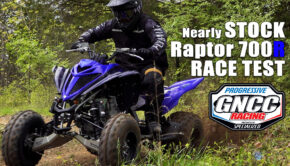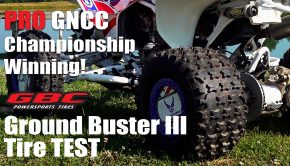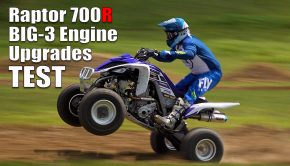Published on May 16th, 2024 | by Joe
2024 Yamaha Raptor 700R Test Review
For 2024, the Yamaha Raptor 700R turns 18-years-old, remaining as relevant as it was the day of its release. A sport ATV loved world-wide, due to its historically unmatched balance of performance, durability, and comfort. Since our last test of the Raptor 700R in 2016, very little has changed. Unrivaled, Yamaha believes there’s been little reason for updates.
For this test, we wanted to accomplish two things. First, get a fresh take on the Raptor from experienced riders who’ve never ridden it. Secondly, with the lack of modern sport ATV options and nearly every sport ATV ever produced being utilized for various types of racing at some point in history, we’re wondering if it’s past time to start considering the 700’s as a potential race machine for different disciplines.
To help us compile a fresh review and evaluate the Raptor’s potential for competition in an area where its stock attributes seem ideally suited, we met up with ATV cross country 30+ GNCC racer, Doug Kiric, and GNCC B class racer, Isaac Hart. Our test was held at Hidden Springs Ranch in Springfield, Ohio, where the OXCR holds races, providing a cross-country loop with mixed terrain that our riders were very familiar with.
Trim Packages
The Raptor 700 line begins with the standard Raptor 700. It foregoes the 700R’s more adjustable suspension and adjustable front brake lever to achieve its $9,699 price tag. It’s a good choice for those who don’t plan on tuning their stock, or having them revalved by an aftermarket tuner.
The 700R gains fully adjustable KYB shocks, providing a much greater level of adjustability for different rider weights, riding styles, and skill levels. An adjustable front brake lever is another welcomed upgrade. In our opinion, at $10,299, the 700R is easily worth the extra $600 for riders wanting to be able to finetune the ride of their machine. or want to be able to revalve and respring the stock shocks, which is far more affordable than purchasing aftermarket shocks.
The 700R special Edition model adds an aluminum bumper and aluminum heel guards from Yamaha’s GYTR line of accessories in addition to unique color schemes and graphics. If you love the color options and added aluminum accessories, they’ll set you back $600 more than the 700R with the SE retailing for $10,899. If it were us, we’d go with the 700R and spend that money on a full set of GYTR aluminum skid plates before we left the dealer to protect our investment.
Engine
The Raptor is powered by a 686cc, water-cooled, four-stroke engine featuring a four-valve, SOHC head design. Its displacement is achieved through a 102mm bore x 84mm stroke. A 10:1 compression ratio strikes a nice balance between reliability and performance. We typically run ethanol free, 90 octane pump gas or high octane race fuel to maintain a clean running engine and fuel system. Yamaha Fuel Injection delivers the gas via a 44mm throttle body. Air is drawn from a large airbox under the seat providing tool-less access to the air filter for maintenance.
A manual transmission and chain drive make the most efficient and responsive use of the top-end’s power. The Raptor features a five-speed, wide ratio, manual clutch equipped transmission with a 520 X-ring chain providing final drive to the rear wheels. Turn the knob on the right front fender and shift down from first and reverse gear is there if you get in a jam; a convenience for trail riders and a time saver if you were to choose the Raptor for racing.
The Raptor fires to life with push button electric start. It starts up reliably with most of our testing taking place in the 30s to 50s. Warming up quickly, the Raptor delivers clean throttle response throughout the RPM range with no annoying hesitations or hiccups.
Our riders found the Raptor to deliver a good amount of low-end power, beneficial when working their way through tricky low-speed rock gardens and off-camber sections of the trail. In stock form, Isaac found the low-end power to be a little underwhelming for a big-bore single, due to running lean off the bottom to meet EPA emission standards. Still, low-end power and torque greatly exceeds any 450 or most other sport ATVs ever produced.
The engine effortlessly builds RPMs at a controllable pace beginning to do its best work as it enters the midrange. The Raptor rockets forward throughout the midrange delivering a mind blowing combination of traction and acceleration. Both our riders were impressed with how much forward momentum the Raptor could deliver in the fields and on steep climbs. Compared to their 450 race machines, they were also impressed with how efficient the Raptor was at generating grip on slick leaf strewn hills or powering straight up rocky climbs where a 450’s more explosive power delivery and need to ride higher in the RPMs can create more deflection off line.
Our riders quickly learned to upshift a while before the rev limited kicked in to maximize acceleration. An incredible midrange motor makes the Raptor easy to ride fast whether you’re lugging it or over-revving a bit. It’s faster than a 450 in a drag race, more forgiving of mistakes, and is much happier to go out for a casual cruise.
Our riders praised the light, smooth action of the clutch, which they felt was rarely needed due to the engine’s good low-end. Shifting is smooth and the gear ratios seem nearly perfect, although Isaac did mention that he would like to add one tooth to the rear sprocket to lower 2nd gear a small amount for steep, technical climbs. This would have little effect on the Raptor’s blisteringly fast top-speed.
Based on our previous tests, simply adding the big-3 engine upgrades, intake, exhaust and fuel module would negate the need for a gearing change by further enhancing the Raptor’s strong low-end, midrange and increase top-end power and over-rev.
Fuel Customs Intakes, the Big-3 engine upgrade experts, dyno test with a majority of the Raptor pipes on the market. They tell us that pairing their intake with a good aftermarket exhaust and properly tuned fuel controller boost peak horsepower from 45 in stock trim to between 52-55HP with increased horsepower across the usable RPM range. Plus an added 1 ½ FT LBS of torque. If you already have an aftermarket exhaust and tuner, adding a fuel customs intake can add up to 3 additional horsepower at peak and up to 6hp in the overrev. Their recommendations made a huge difference on our Yamaha Raptor 700RR project. For help choosing the right setup for you Raptor, reach out to Fuel Customs at fuelcustoms.com.
Suspension and Handling
The Raptor uses a hybrid frame with a steel and aluminum frame. The front section and lower frame rails are constructed of steel. They connect to an aluminum rear section with a removable aluminum subframe. Its hybrid design is to help optimize strength, weight, and handling. Dual A-Arms suspension is used up front delivering 9.1” of wheel travel. With a lightweight, linkage equipped cast aluminum swingarm and solid axle are used out back providing 10.1:” of travel. The swingarm and axle carrier feature a concentric chain adjustment system making chain adjustment a snap.
Fully adjustable KYB shocks provide threaded spring preload plus high and low-speed compression and rebound damping adjustments at both ends. We’ve found them to deliver a lot of usable adjustment. An aftermarket suspension tuner can extract even more performance from them. We have a couple videos demonstrating what aftermarket tuners can do with the Raptor’s stock shocks you might want to check out after watching this test.( Links in description) The Raptor rolls on purpose built Maxxis tires, 22×7-10 front and 20×10-9 rear. They are mounted on good quality, lightweight aluminum wheels.
Overall, the Raptor measures in at 45.5” in width, a bit narrow by modern trail standards, but otherwise it’s scaled for excellent comfort and control. It has a 50.4” wheelbase, a seat height of 32.7”, and overall height of 43.9” with a max ground clearance of 9.5”. While many imagine the 700R is dramatically heavier than the race-focused YFZ450R, in reality, it’s only 17 pounds heavier with a curb weight of 422 lbs. For more on how the Raptor and YFZa compare, check out our Raptor 700R VS YFZ450R Shootout.
Throughout testing, our riders felt no need to touch the shock settings. They were in agreement that they couldn’t ask for better performing shocks on the root and rock strewn trails on which we tested. Small bump compliance was good while resisting bottoming flat landing from around four-feet of air. They’re nearly perfect for trail, and we’ve previously found them to be firm enough for playing around on the motocross track.
Doug noted that the combination of the rear suspension and high-torque engine resulted in the back end squatting down under acceleration, delivering an incredible amount of grip and traction. This was especially beneficial on rough technical climbs.
Both our riders praised the 700 for its excellent steering precision everywhere on the trail. Steering is light and agile in the tight sections, allowing for precise line selection while making steering just a bit nervous at super high-speeds. Adding a good steering stabilizer would only make the steering even better everywhere. The Raptor is a good cornering machine, only drawing criticism in very tight turns where our riders wanted to steer with the back end due to the Raptor’s incredible grip and taller center of gravity. Being used to lower, wider race machines added to this feeling. It seemed overall that both racers had a lot of positive things to say about the Raptor’s suspension and handling with only a few small criticisms, which was probably a bigger surprise to them than it was to us.
Brakes
Dual hydraulic disc brakes front and a single hydraulic disc brake rear featuring dual-piston calipers slow the Raptor. Our riders were most surprised by how much the big four-stroke engine reduced their demand on the brakes. Roll off the throttle for smooth, subtle engine braking and downshift for more stopping power. Of course, rear wheel engine braking is only so effective on steep hills or slowing quickly from speed. As always, the Raptor’s brakes received praise for stopping power, feel, and their ability to be easily modulated.
Ergonomics and other Details
The cockpit consists of a long, plush seat that’s pretty easy to move around and, as mentioned, a bit taller than the YFZ’s, making sitting more comfortable and standing up easier. The steel handlebars are on the tall side with a fair amount of sweep. The brake and clutch levers and perches are comfortable and well-constructed. The parking brake lever is the best in the business. An adjustable front brake lever is a nice touch on the R and SE models. The switches feel solid and the thumb throttle drew no complaints from our riders.
45mm wide serrated footpegs are wide enough for most riders. The heel guards are typically a welcomed safety feature. However, on this day, they rapidly built up with mud forcing the riders to stop from time to time and dig the mud off the heel guards. Netted heel guards are a must for muddy conditions.
Both our riders felt they could easily move front to back on the Raptor and how its taller seat and side panels provided a better surface to grip with their legs compared to the YFZs they normally ride. At 5’8”, Doug noticed the taller seat with a bit hanging off the side, but was more annoyed by the super tall bars that were right in his face when cornering. At 6’3” Isaac felt right at home on the Raptor bars and all. If you’re under 6”, you might want to look into lower bars.
Dual 35 watt Krypton headlights and an LED tail and brake light provide ample light for night cruises. That being said, for today’s asking price, we think most riders would prefer LED headlights, and the Raptor certainly deserves a proper set of aluminum handlebars.
Race Potential
Skeptics of how the Raptor would handle prior to riding it, both riders came away confident in the Raptor’s ability to be built into a competitive cross-country race machine. They were confident that it could make a great vet class race machine due to its forgiving engine, handling, and comfortable ergonomics. It doesn’t wear you out as quickly as a 450, and is easier to ride when you are worn out. Most importantly of all, it’s quick with lots of aftermarket support for building a race machine if that interests you.
Conclusion
No matter who we’ve invited to throw a leg over the Raptor for us through the years, they’ve always come away impressed. Most impressive to us is seeing how quickly two cross-country racers took to a machine that has been mainly overlooked by racers for nearly two decades. As popular as it is world-wide, there are obviously still riders out there missing out on what the King of sport quads has to offer.
Our riders felt the Raptor 700 is a great sport ATV for short trips or long rides. It’s well suited for the woods, the dunes, desert, or just about anywhere you want to take it. Watching during testing, and listening to our rider’s feedback, more than anything, the 2024 Yamaha Raptor 700R continues to excel at delivering maximum fun.
2024 Yamaha Raptor 700R Test Ratings
Summary: Our riders felt the Raptor 700 is a great sport ATV for short trips or long rides. It’s well suited for the woods, the dunes, desert, or just about anywhere you want to take it. Watching during testing, and listening to our rider’s feedback, more than anything, the 2024 Yamaha Raptor 700R continues to excel at delivering maximum fun.










